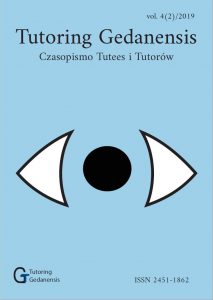Charakterystyka i funkcje ekologiczne organizmów tworzących łąki podwodne Zostera marina Zatoki Puckiej
Słowa kluczowe:
łąki podwodne, zoobentos, różnorodność funkcjonalna, fitobentos, peryfiton, Zostera marinaDownloads
Bibliografia
Bostrom, C., Bonsdorff, E., 1997. Community structure and spatioal variation of benthic invertebrates associated with Zostera marina (L.) beds in the northern Baltic Sea. Journal of Sea Research 37, 153–166.
Bostrom, C., Bonsdorff, E., 2000. Zoobenthic community establishment and habitat complexity – the importance of seagrasses shoot-density, morphology and physical disturbance for faunal recruitment. Marine Ecolory Progress Series 205, 123–138.
Czarnecka, P., Dąbrowska, A., Igielska, M., Janas, U., Kendzierska, H., 2013. Znaczenie łąk podwodnych w Zatoce Gdańskiej. Conference: Young Scientists conference World Water Day, Conference paper.
Dąbrowska, A. H., Janas, U., Kendzierska, H., 2016. Assessment of biodiversity and environmental quality using macrozoobenthos communities in the seagrass meadow (Gulf of Gdańsk, southern Baltic). Oceanological and Hydrobiological Studies, 45(2), 286.
Dz.U. z 2014 r. nr 0, poz. 1409 – Roz porządzenie Ministra Środowiska z dnia 9 października 2014 r. w sprawie ochrony gatunkowej roślin.
Gonciarz, M., Wiktor, J., Tatarek, A., Węgleński, P., Stanković, A. 2014. Genetic characteristic of three Baltic Zostera marina populations. Oceanologia, 56(3), 549–564.
Heck Jr., K. L., Hays, G., Orth, R. J., 2003. Critical evaluation of the nursery role hypothesis for seagrass meadows. Marine Ecology Progress series, 253, 123–136.
Hemminga, M. A., Duarte, C. M., 2000. Seagrass ecology. Cambridge University Press.
Herringshaw, L.G., Sherwood, O.A., McIlroy, D., 2010. Ecosystem engineering by bioturbating polychaetes in event bed microcosms. PALAIOS, 25, 46–58.
Howard, R. K., Short, F. T., 1986. Seagrass growth and survivorship under the influence of epiphyte grazers. Aquatic Botany, 24, 287–302.
Janas, U., Bonsdorff, E., Warzocha, J., Radziejewska, T., 2017. Deep soft seabeds. Biogeochemical cycles, Springer, 359–385.
Jankowska, E., De Troch, M., Michel, L.N., Lepoint, G., WłodarskaKowalczuk, M., 2018. Modification of benthic food wab structure by recovering deagrass meadows as revealed by trophic makers and mixing models. Ecological Indicators, 90, 28–37.
Jankowska, E., Michel, L.N., Lepoint, G., Włodarska-Kowalczuk, M., 2019. Stabilizing effects of seagrass meadows on coastal water benthic food webs. Journal of Experimental Marine Biolog y and Ecolog y, 510, 54–63.
Kaźmierczakowa, R., Bloch-Orłowska, J., Celka, Z., Cwener, A., Dajdok, Z., Michalska-Hejduk, D., Pawlikowski, P., Szczęśniak, E., Ziarnek, K., 2016. Polska czerwona lista paprotników i roślin kwiatowych. Polish red list of pteridophytes and flowering plans. Kraków, Instytut Ochrony Przyrody Polskiej Akademii Nauk.
Leidenberger, S., Harding, K., Jonsson, P.R., 2012. Ecology and distribution of the Isopod genus Idotea in the Baltic Sea: key species in a changing environment. Journal of Crustacean Biology, 32(3), 359–381.
Levinton, J., 1995. Bioturbators as Ecosystems Engineers: Control of the Sediment Fabric, Inter-Individual Interactions, and Material Fluxes. [w:] Jones C., Lawton J. H., (red.), Linking species & ecostystems, Springer- -Science+Business Media, Dordrecht, 29–36.
Nelson, W.G., Bonsdorff, E., 1990. Fish predation and habitat complexity: Are complexity thresholds real? Journal of Experimental Marine Biology and Ecology, 141, 183–194.
Philippart, C. J. M., 1995. Effect of periphyton grazing by Hydrobia ulvae on growth of Zostera noltii on a tidal flat in the Dutch Wadden Sea. Marine Biology 122, 431–437.
Pliński, M., 1995. Hydrobiologia, Sopot Podbielkowski, Z., Tomaszkiewicz, H., 1979. Zarys hydrobotaniki Państwowe Wydawnictwo Naukowe, Warszawa SatBaltyk 2019 http://satbaltyk.iopan.gda.pl [Dostęp: 14.01.2019].
Short F. T., Polidoro B., Livingstone S.R., Carpenter K.E., Bandeira S., Bujang J. S., Zieman J. C., 2011. Extinction risk assessment of the world’s seagrass species, Biological Conservation., 144 (7), 1961–1971.
Sokołowski, A., Wołowicz, M., Asmus, H., Asmus, R., Carlier, A., Gasiunaite, Z., Gremare, A., Hummel, H., Lesutiene, J., Razinkovas, A., Renaud, P. E., Richard, P., Kędra, M., 2012. Is benthic food web structure related to diversity of marine macrobenthic communities? Estuarine, Coastal and Shelf Science 108, 76–86.
Sundin, J., Jacobsson, O., Belgrund, A., Rosenqvist, G., 2011. Straight-nosed pipefish Nerophis ophidion and broad-nosed pipefish Sygnanthus typhle avoid eelgrass overgrown with filamentous algae. Journal of Fish Biology, 78, 1855–1860.
Włodarska-Kowalczuk, M., Jankowskam E., Kotwicki, L., Bałazy, P., 2014. Evidence of Season-Dependency in Vegetation Effects on Macrofauna in Temperate Seagrass Meadows (Baltic Sea), PLoS ONE, 9(7).
Vincent, A., C., J., Berglund, A., Ahnesjö, I., 1995. Reproductive ecology of five pipefish species in one eelgrass meadow Environment Biology of Fishes 44, 347–361.
https://www.iopan.pl/projects/Zostera/planting-pl.html [Dostęp: 13.05.19; 18:05]

 Uniwersyteckie Czasopisma Naukowe
Uniwersyteckie Czasopisma Naukowe



